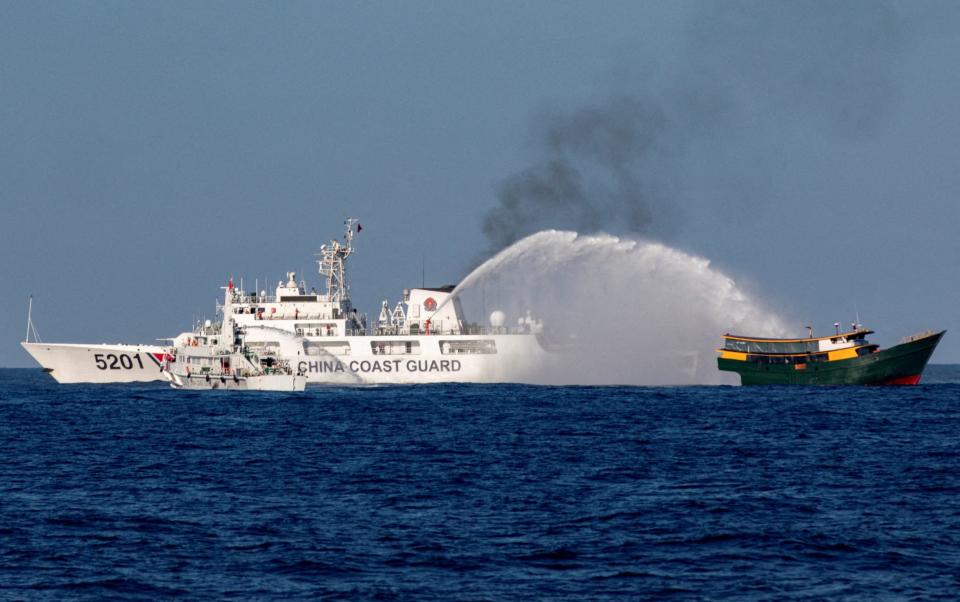China attacks Philippine ship with our reporter on board

Nicola Smith, the Telegraph’s Asia correspondent, was on Tuesday aboard a Philippine coast guard vessel accompanying fishermen near the controversial Scarborough Reef in the South China Sea when her vessel was attacked by the Chinese coast guard.
We are on a mission with the Philippine Coast Guard to accompany a supply ship carrying fuel and food to fishermen near Scarborough Reef.
The shoal is one of several features in the South China Sea claimed by China, even though it is less than 200 miles from the Philippines’ economic exclusion zone.
The aggressive behavior of Chinese ships in recent months is a sign of the growing escalation between Manila and Beijing, which could become a major geopolitical flashpoint.
Two ships left Manila, the Philippine Coast Guard ship BRP Bagacay and the supply ship BRP Datu Bankaw.
We traveled through the night, and at around 5 a.m., still more than three hours from the shoal, two Chinese Coast Guard (CCG) vessels were spotted on the horizon, clearly following us.
The number increased to five plus one warship.
About 24 nautical miles from the shoal, the CCG vessels engaged in an aggressive game of cat and mouse with the two Philippine vessels, trying to separate them and blocking the path to the shoal.
The coast guard vessels were approaching us within about 30 meters (100 feet), forcing our ship’s captain to take evasive action.
The CCG ships were cutting closely in front of us, clearly also trying to send a political signal regarding China’s claims to the shoal.
The Filipinos accelerated and the CCG retreated temporarily until we came within sight of the southern entrance to the shoal, blocked by a floating barrier.
At that time, the supply ship was 12 nautical miles behind the Philippine Coast Guard trying to attract fishing boats to resupply. The Philippine Coast Guard vessel was a decoy.
About 1,000 meters from the south entrance, around 9 a.m., CCG vessels came from behind and activated the water cannons, so powerful that they broke the plastic canopy at the rear of the boat and folded its metal structure.
There is now debris all over the back of the boat – a broken table, large pieces of thick plastic. Anyone under the canopy could have been seriously injured.
The crew and journalists sheltered in a passage as water pounded the deck and pounded the side of the ship, also damaging a railing. The supply ship was also hit by water cannons.
For about an hour, the CCG ships continued to fire their water cannons, following the Philippine ship in a pincer movement and hitting it directly three times, trying to push it back from the shoal.
Our crew was in radio contact with the CCG, asking them to turn off the water cannons and also reading a statement asserting the Philippines’ claims to the shoal, which is within their EEZ.
There was no aggressive action by the Philippine Coast Guard, only evasive behavior.
Beijing asserts its sovereignty in the South China Sea
The shoal is one of several disputed territories in the South China Sea and the site of frequent clashes between Chinese and Philippine coast guards and fishing vessels.
Beijing claims sovereignty over almost the entire South China Sea and its 11 billion barrels of untapped oil and 190 trillion cubic feet of natural gas, and ignores competing claimants Brunei, Indonesia, Malaysia, Philippines, Taiwan and Vietnam.
China claims the triangular-shaped Scarborough Reef and calls it Huangyan Island, even though it lies within the Philippines’ 200-nautical-mile exclusive economic zone as defined by international maritime law.


China effectively took control of the Scarborough Shoal Lagoon in 2012 after its coast guard clashed with Philippine ships in a standoff. Since then, two CCG vessels have been permanently deployed in the lagoon.
Even though it has not built anything on Scarborough Reef since 2016, China is imposing its claims to sovereignty by banning fishing by Philippine boats.
China’s restrictions have led to a notable reduction – up to two-thirds – in what fishermen report usually catching.
Relations between Manila and Beijing deteriorate
In September last year, Philippine forces removed a 300-meter floating barrier installed by China near the shoal, triggering a warning from Beijing.
Last year, China also accused a Philippine military vessel of “illegally entering” waters near Scarborough Shoal. The Chinese coast guard said it had taken steps to chase away the Philippine navy gunboat.
In another incident in December, the United States condemned a high-seas attack by Chinese coast guard and suspected militia ships that repeatedly detonated water cannons to prevent three vessels from Filipino fishing to access the shoal.
The assault, one of the most aggressive in 2023, caused “significant damage” to communications and navigation equipment on one of three Bureau of Fisheries and Aquatic Resources vessels, Philippine officials said.
The ships had traveled to the region to provide humanitarian aid, mainly free fuel and Christmas grocery packages, to poor Filipino fishermen aboard nearly 30 boats.
They said the swarm of Chinese coast guards and accompanying ships took dangerously aggressive measures, including using water cannons at least eight times, as the Philippine government ships approached about 2.6 to 3.5 km (1.6 to 2 miles) from Scarborough Shoal.
These tense clashes take place against a backdrop of deteriorating relations between Manila and Beijing, with the latter increasingly wary of the Philippines’ growing alliance with the United States.
This includes strengthening defense cooperation and better access for US forces to Philippine military bases. The Philippines is seen as an important stopover in the event of a crisis in the Taiwan Strait, but the conflict in the South China Sea is also seen as a flashpoint in its own right.
Broaden your horizons with award-winning British journalism. Try The Telegraph free for 3 months with unlimited access to our award-winning website, exclusive app, money-saving deals and more.
yahoo




